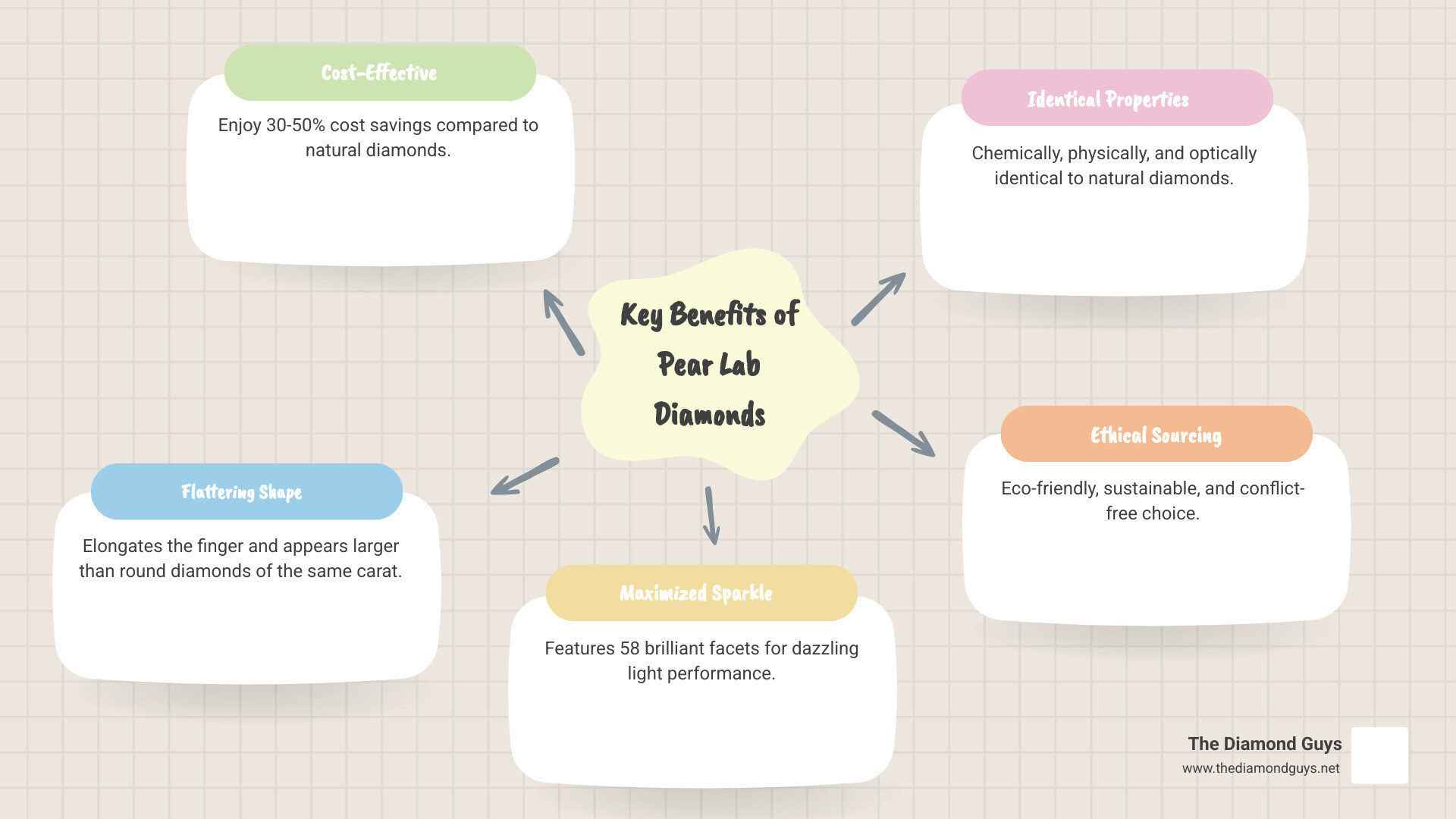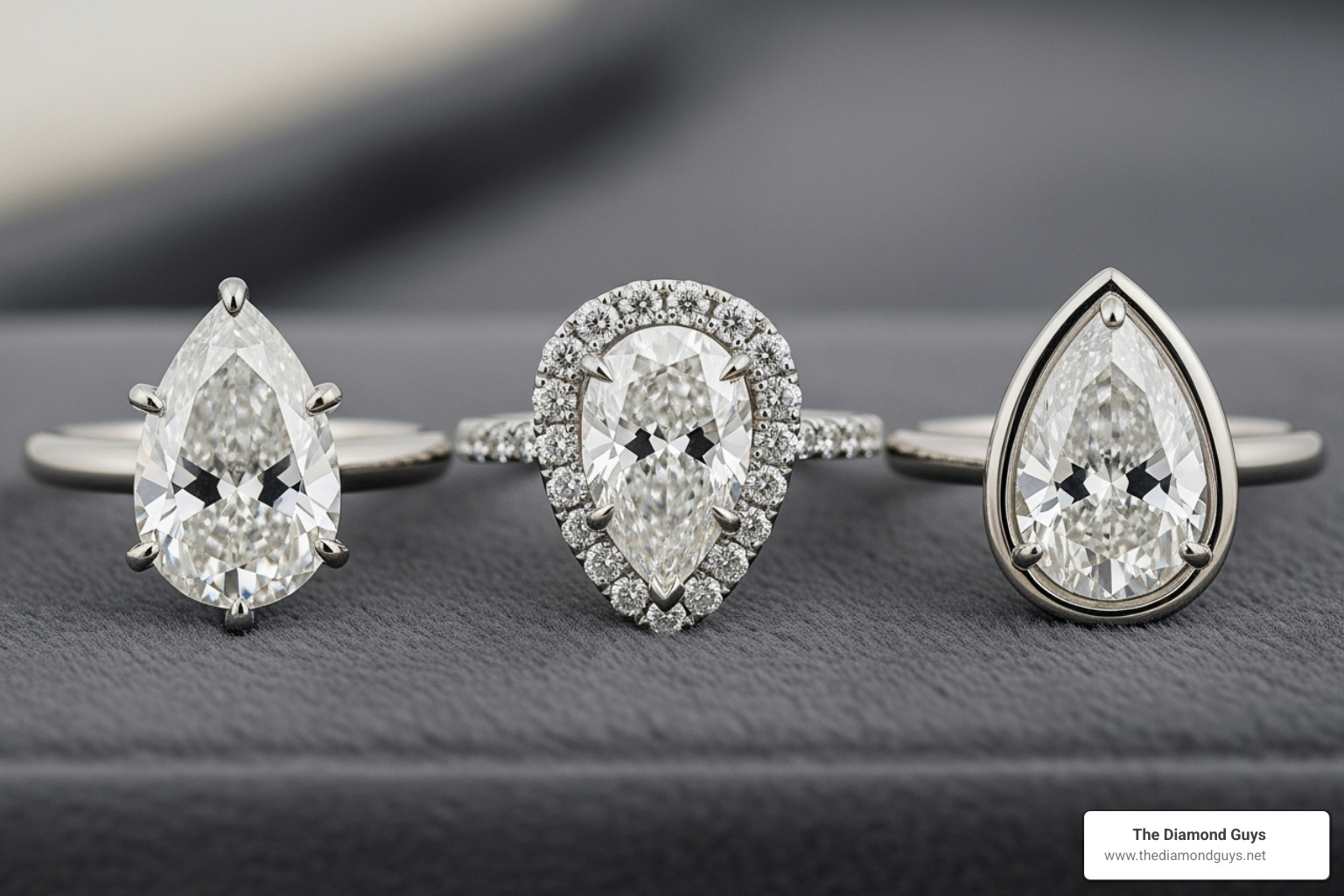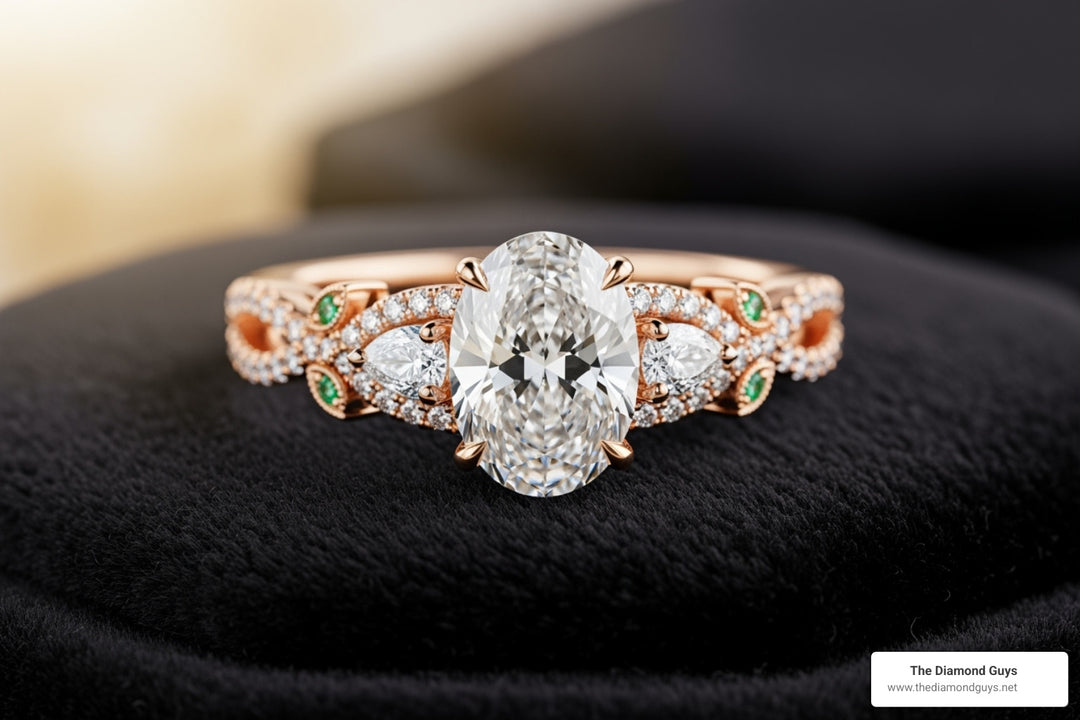Your Guide to Buying Pear Lab Diamonds
Why Pear Lab Diamonds Are Capturing Hearts
A pear lab diamond combines the timeless elegance of a classic diamond with the ethical sourcing and affordability of modern lab-grown technology. If you're considering one, here's what you need to know at a glance:
| Key Consideration | What to Look For |
|---|---|
| Shape & Appeal | Teardrop silhouette with 58 facets; elongates the finger |
| Cost | 30-50% less than natural diamonds; 15-30% less than round cuts |
| Quality | SI1-VVS2 clarity; G-E color; ideal length-to-width ratio 1.55-1.70 |
| Setting | Minimum 5 prongs with V-prong at point to protect the tip |
| Ethical Value | Chemically identical to natural diamonds; conflict-free |
Pear shaped diamonds—also called teardrop diamonds—trace their origins back to the 15th century. Today, they're experiencing a surge in popularity among couples who want something unique and sophisticated. The pear cut merges the brilliance of a round diamond with the neat taper of a marquise, creating a hybrid that offers both sparkle and style.
Lab-grown versions deliver all the visual appeal and durability of natural diamonds at a fraction of the cost. They're chemically, physically, and optically identical to mined stones, but they're created in weeks rather than millennia. This means you can afford a larger, higher-quality diamond while supporting ethical and sustainable practices.
The shape itself makes fingers appear longer and more slender, and the larger surface area means a pear lab diamond looks bigger than a round diamond of the same carat weight. That's a win for both aesthetics and budget.
I'm Morgan Price, and I've spent years helping couples steer the diamond buying process with transparency and care. Throughout my work with lab-grown diamonds, I've seen how a pear lab diamond offers modern buyers the best of both worlds—ethical sourcing and exceptional value—without compromising on beauty or quality.

What Makes a Pear Lab Diamond So Special?
There's something undeniably captivating about a pear lab diamond. It's a true diamond in every sense—chemically, physically, and optically identical to one pulled from the earth—but created in a controlled laboratory environment. The result is a stunning gemstone that brings together elegance, brilliance, and exceptional value.
What truly sets the pear shape apart is its distinctive teardrop silhouette. A hybrid of a round brilliant and a marquise cut, it features 58 carefully arranged facets that create dazzling sparkle and fire. Beyond its beauty, the pear shape carries meaningful symbolism, often representing tears of joy or empowerment and independence.

One of its most loved features is the flattering elongating effect on the finger, making it appear longer and more slender. A pear diamond also looks larger than other shapes of the same carat weight due to its elongated surface area, giving you more visual impact for your investment.
Choosing a pear lab diamond also comes with significant advantages:
- Ethical Sourcing: Lab-grown diamonds are created without the environmental damage or ethical concerns tied to traditional mining, making them a genuinely sustainable and conflict-free choice.
- Affordability: Lab-grown diamonds typically cost 30-50% less than natural diamonds. The pear shape itself is also 15-30% less expensive than a round diamond of the same quality, offering serious savings.
- Identical Quality: Despite the lower price, you're not compromising. Lab-grown diamonds have the same hardness (a perfect 10 on the Mohs scale), brilliance, and fire as mined diamonds. The only difference is their origin.
- Consistent Quality: Because they are created in controlled conditions, we can offer excellent cut, color, and clarity across a wide range of options to match your vision.
Want to dive deeper into how lab diamonds compare to natural ones? Check out our comprehensive guide: Lab Diamonds vs Real Diamonds.
How to Select the Perfect Pear Lab Diamond
Finding your perfect pear lab diamond involves understanding the 4CsCut, Color, Clarity, and Caratalong with pear-specific traits like the length-to-width ratio and the bow-tie effect. Don't worry, we'll walk through it all together.
Mastering the 4Cs for a Pear Lab Diamond
Let's start with the fundamentals for evaluating your pear lab diamond.
Cut is paramount for a pear shape's sparkle. It refers to how well the facets are arranged to reflect light. A well-cut pear will dance with light, while a poor cut can look lifeless. Look for an excellent or very good cut grade, as this also helps minimize the bow-tie effect. When cut to perfection, a pear diamond shows off all 58 facets of brilliant fire.
Color is graded from D (colorless) to Z (light yellow/brown). For a crisp, icy look in a pear lab diamond, we recommend the D through G range. However, pear shapes are forgiving with color, and a well-cut H or I grade can still appear beautifully white, especially in a white gold or platinum setting. This can be a great way to save on your budget. Want to dive deeper into color? Check out our guide on What is Diamond Color.
Clarity measures a diamond's internal and external flaws. An eye-clean SI1 or SI2 clarity grade is often a great value for pear shapes, as any tiny inclusions are not visible to the naked eye. For stones over 1 carat, consider upgrading to VS2 or VS1 to ensure a flawless appearance, as inclusions can be more noticeable in larger diamonds. Learn more with our article: What Diamond Clarity Is Best.
Carat refers to the diamond's weight. Because of its elongated shape, a pear lab diamond looks larger than other shapes of the same carat weight. This gives you impressive finger coverage and visual impact, offering more bang for your buck. Curious about carat weight? We've got you covered: What is Diamond Carat Size.
Beyond the 4Cs: Ratio and the Bow-Tie Effect
Two other factors are crucial for selecting a beautiful pear-shaped diamond.
The length-to-width ratio determines the diamond's silhouette. While it's a matter of personal taste, most people prefer a ratio between 1.50 and 1.75 for a classic, balanced teardrop shape. A lower ratio creates a wider look, while a higher ratio results in a more elongated, narrow stone. We encourage you to view different ratios to find what you love.

The bow-tie effect is a dark, bow-tie-shaped shadow across the diamond's center caused by light leakage. While a slight bow-tie is normal, a prominent one detracts from the stone's brilliance. The best way to identify and minimize the bow-tie is to prioritize cut quality and examine 360-degree videos of the diamond. Our expert gemologists can help guide you toward stones with minimal bow-ties and maximum sparkle. For an independent overview of pear-shaped diamonds, see the GIA guide: Pear-Shaped Diamond Buying Guide.
When you're ready to choose, review the diamond's certification report from a respected lab like IGI (International Gemological Institute) or GIA (Gemological Institute of America). This report provides a complete overview of the 4Cs, measurements, and other key characteristics, guaranteeing the diamond's quality.
The beauty of working with us at The Diamond Guys is that you're never navigating this alone. We're here to answer questions, show you options, and help you find a pear lab diamond that's absolutely perfect for you.
Popular Settings and Styles for Pear Diamonds
You've found your perfect pear lab diamond—now it's time to choose a setting that improves its beauty while keeping it secure. The pointed tip of a pear diamond is its most vulnerable feature, so the right setting is crucial.
Choosing a Secure and Stylish Setting
Pear-shaped diamonds are versatile and look stunning in many styles. The key is to ensure the delicate point is protected.
- Solitaire: A timeless solitaire setting lets your pear lab diamond take center stage. For security, it should have at least five prongs, including a special V-prong to cradle the vulnerable pointed tip from chips and snags.
- Halo: A halo setting encircles the center stone with smaller diamonds, adding sparkle and making your pear lab diamond appear larger. A quality halo will also feature a V-prong for protection.
- Bezel: For maximum security, a bezel setting wraps the diamond's entire edge in a thin metal rim. This modern style is ideal for active lifestyles as it offers the best protection for the point.
- Three-Stone: Symbolizing the past, present, and future, this setting flanks your center pear with smaller diamonds, such as rounds, baguettes, or even smaller pears.
- Cathedral: This setting features graceful metal arches that rise from the band to support the diamond, adding height and an neat, integrated look.

No matter the style, settings with at least five prongs are highly recommended to protect the pointed end. For metal choices, platinum is a durable and naturally white option for the head, ensuring it won't cast color onto your diamond. A platinum head on a yellow or rose gold band creates a popular and beautiful two-tone look. For more guidance, check out our guide: How to Choose a Diamond Ring Setting.
Modern Trends: From Toi et Moi to East-West
Several exciting design trends are redefining engagement rings featuring pear lab diamonds.
- Toi et Moi: These romantic "you and me" rings feature two stones side-by-side. Pairing a pear lab diamond with another shape creates a meaningful, asymmetrical design.
- East-West Orientation: A contemporary twist is the east-west setting, where the diamond is set horizontally across the finger for a wider, more dramatic look.
- Hidden Halos: A hidden halo places a circle of small diamonds beneath the center stone, visible only from the side for a touch of secret sparkle.
- Split Shank Bands: The band splits as it approaches the diamond, creating an architectural detail that makes the center stone appear more prominent.
These trends showcase the versatility of the pear lab diamond. Whether you prefer classic elegance or modern edge, there's a setting that will make your love story shine.
Caring for Your Ring
Your pear lab diamond ring is a cherished investment. While lab-grown diamonds are exceptionally durable—ranking a perfect 10 on the Mohs hardness scale—they require thoughtful care to maintain their sparkle.
The pointed tip of your pear diamond is its most vulnerable part and can chip if knocked against a hard surface. A protective setting with a V-prong is essential, but mindfulness during daily activities is also key to keeping it safe.
Daily Care and Cleaning
Oils, lotions, and dust can build up on your diamond, dulling its brilliance. Luckily, cleaning is simple.
Your best cleaning routine is to soak your ring in a bowl of warm water with a few drops of mild dish soap for 10-15 minutes. Use a soft toothbrush to gently scrub around the stone and behind the setting where grime accumulates. Rinse thoroughly under warm running water (with the drain plugged!) and pat dry with a soft, lint-free cloth.
Avoid harsh chemicals like bleach or chlorine, as they can damage the metal setting. It's also best to remove your ring before exercising, gardening, cleaning, or applying beauty products like lotions and hairspray to prevent buildup and reduce the risk of damage.
Long-Term Maintenance and Protection
Beyond weekly cleaning, professional attention will keep your pear lab diamond ring secure and stunning for years to come.
Annual check-ups are essential. We recommend bringing your ring to our Scottsdale or Los Angeles showroom at least once a year for a professional inspection and cleaning. Our jewelers will examine every prong—especially the crucial V-prong—to ensure your diamond is secure. Catching a loose prong early prevents the heartbreak of a lost stone.
Check your prongs between visits by gently tapping the stone. If it moves or you see a bent prong, bring it in for service. When you're not wearing your ring, secure storage in a fabric-lined jewelry box or soft pouch will protect it from scratches.
Insurance provides invaluable peace of mind against loss, theft, or damage. Lab-grown diamonds are fully insurable, just like natural stones. For more details, read our guide: Can You Insure Lab-Grown Diamonds.
With these simple care practices, your pear lab diamond ring will remain as brilliant as the day you first wore it.
Frequently Asked Questions about Pear Lab Diamonds
We love chatting with our clients about pear lab diamonds, and certain questions come up often. Here are the answers to the most common ones to help you feel confident in your choice.
Are pear shaped diamonds more expensive?
Great news for your budget: pear-shaped diamonds are typically 15-30% less expensive than round brilliant diamonds of the same carat and quality. This is because the cutting process for a pear shape is more efficient and wastes less of the rough diamond.
When you combine this with the cost-effectiveness of lab-grown diamonds—which are 30-50% less than natural diamonds—you get exceptional value. This sweet spot often means you can afford a larger or higher-quality pear lab diamond than you might have thought possible.
How should I wear my pear shaped diamond ring?
Traditionally, the pointed end of a pear lab diamond faces toward the fingernail. This orientation creates a beautiful elongating effect that makes the finger appear longer and more slender.
However, there are no rules! Some people prefer the point facing their hand, while others opt for a trendy East-West orientation where the diamond sits horizontally. Our best advice is to try on different styles to see what feels comfortable and looks stunning on your hand.
Do lab-grown pear diamonds get cloudy?
No, pear lab diamonds do not get cloudy. This is a common myth often associated with diamond simulants like cubic zirconia. Lab-grown diamonds are real diamonds, composed of pure carbon in a stable structure that will not dull, discolor, or become hazy over time.
Any diamond, lab-grown or natural, can appear cloudy if it's covered in everyday buildup from lotions, oils, or soap. This film simply blocks light and dulls the sparkle. The solution is regular cleaning. A simple wash with warm water and gentle soap will instantly restore your pear lab diamond to its original, dazzling brilliance. Learn more from our guide: Do Lab-Grown Diamonds Get Cloudy.
Conclusion
Your journey to finding the perfect pear lab diamond is about choosing a symbol that reflects your values, your love, and your vision for the future.
A pear lab diamond offers timeless elegance with a contemporary twist. Its distinctive teardrop silhouette, brilliant 58 facets, and flattering finger-elongating effect make it a standout choice. You get all the beauty and durability of a real diamond while supporting ethical and sustainable practices—at a fraction of the cost of a mined stone.
We've walked through how to select the perfect stone by mastering the 4Cs and pear-specific traits, how to choose a secure and stylish setting, and how to care for your ring to ensure a lifetime of sparkle. What makes a pear lab diamond truly special is that it doesn't ask you to compromise. You get breathtaking beauty, a clear conscience, and exceptional value all in one.
At The Diamond Guys, we understand that buying an engagement ring is one of the most meaningful purchases you'll ever make. Our experts in Scottsdale and Los Angeles are here to offer transparent guidance and a personalized experience to help you feel confident in your choice. We're committed to helping you find a pear lab diamond that tells your unique love story.
Your perfect ring is out there, and we'd be honored to help you find it. To continue learning, explore our comprehensive guide: Learn more about lab-grown vs. real diamonds.




